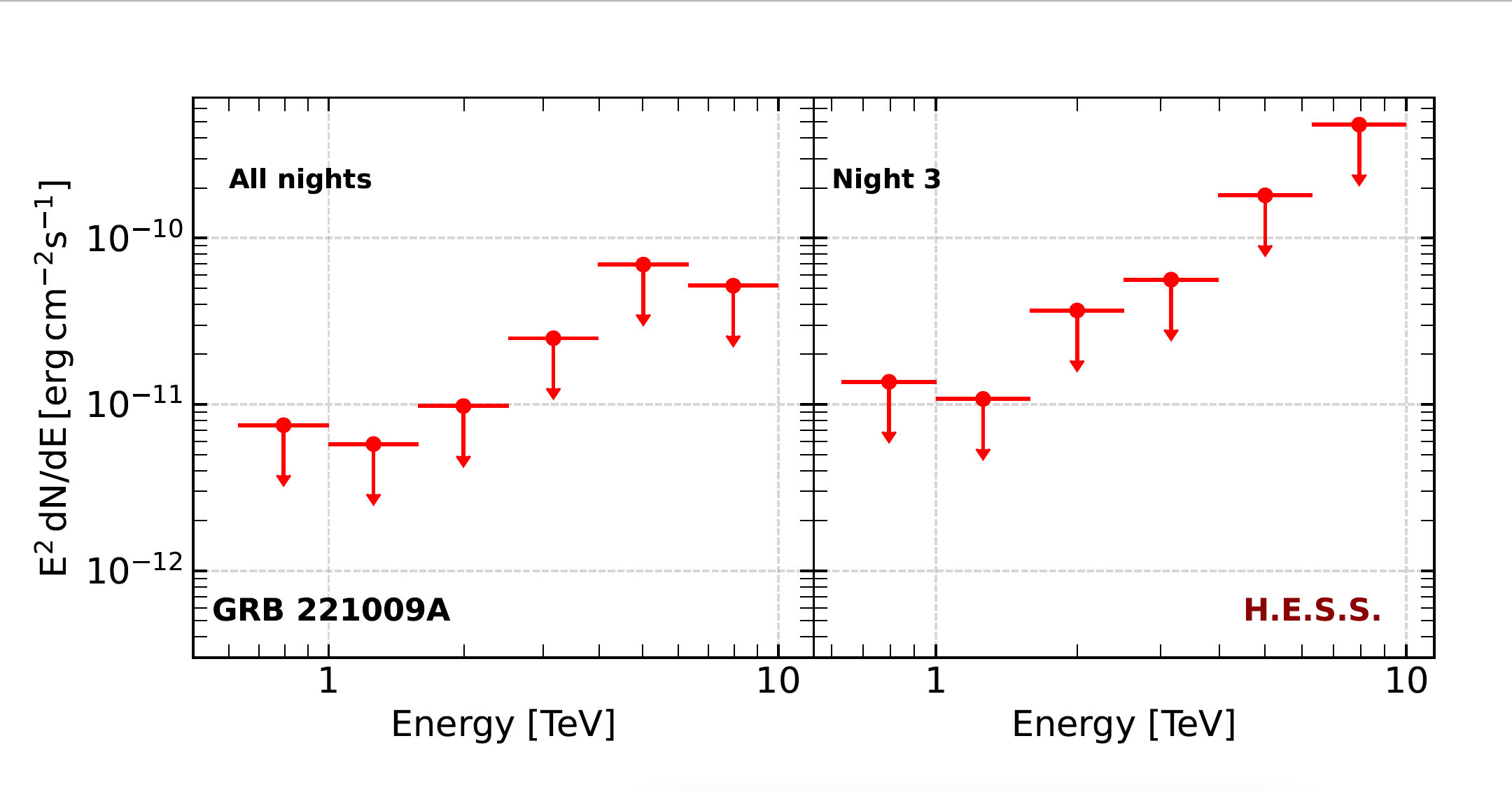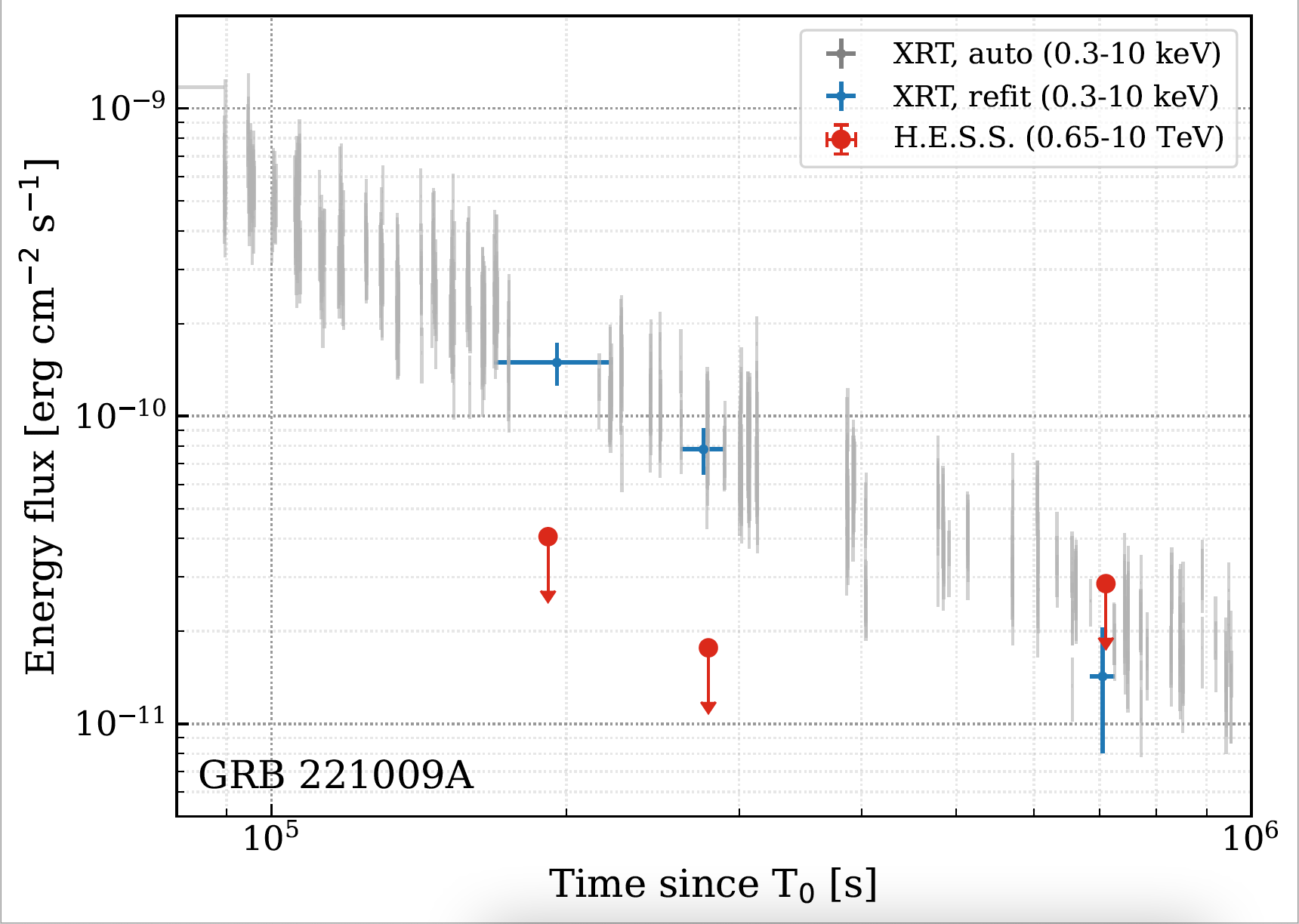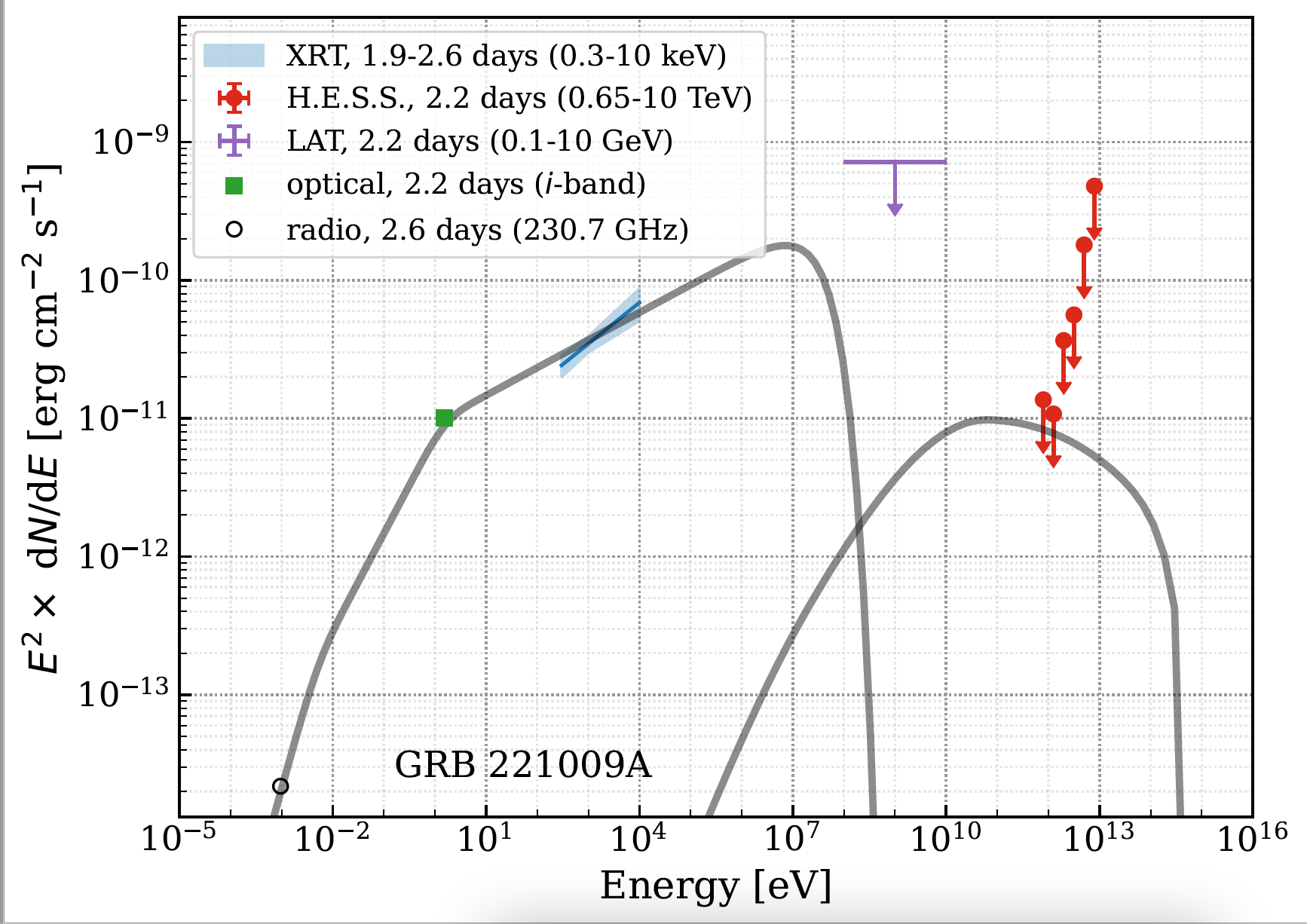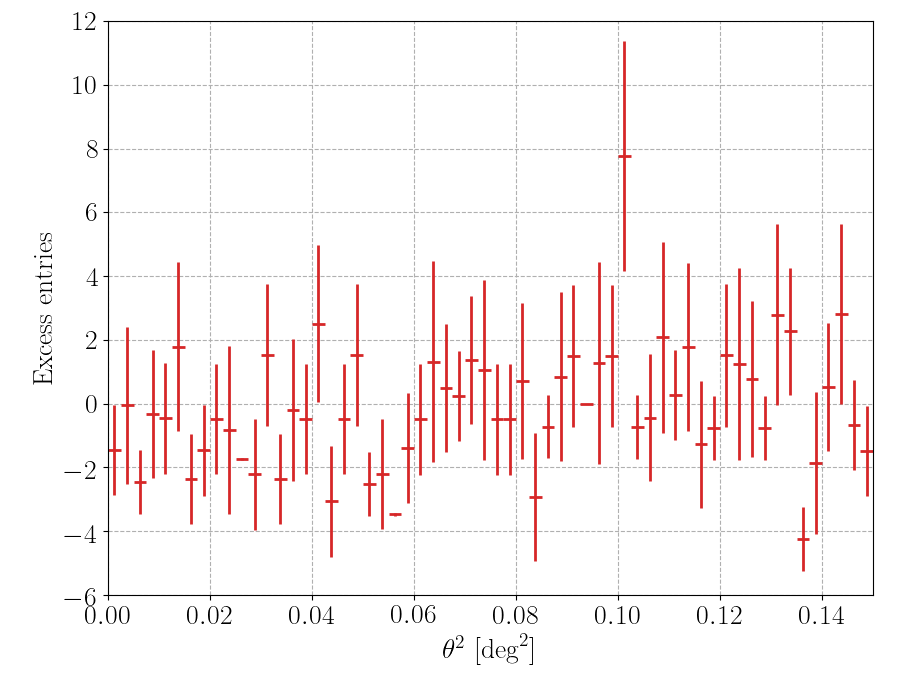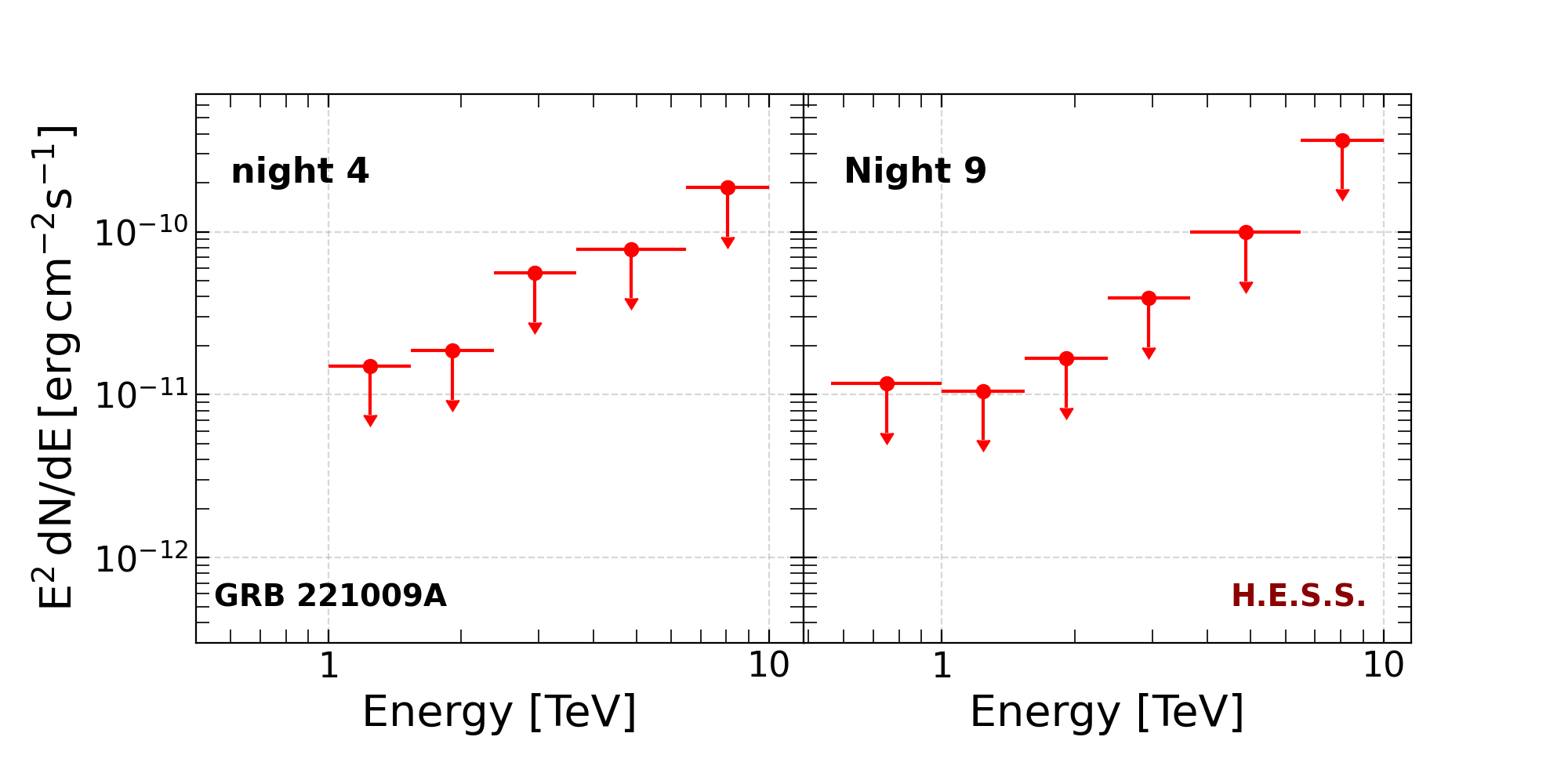Figure 1: Left: Excess count map, Middle: Significance map, Right: Significance distribution of the H.E.S.S. significance map of GRB 221009A for all nights.
Figure 2: 95% C.L. differential flux upper limits on an intrinsic GRB spectrum of the H.E.S.S. observational data taken on GRB 221009A
Left plot, i.e. all nights of H.E.S.S. observations
Right plot, i.e. third night of H.E.S.S. observations
Figure 3: Logarithmic X-ray and gamma-ray Multi-wavelength energy flux light-curves of the GRB 221009A afterglow.
The details of the H.E.S.S. light-curve are given in the paper in Table 2,
The following package contains the data files and a jupyter notebook to reproduce the figure:
Fig3_lightcurves.zip
Figure 4: Multi-wavelength SEDs of the GRB 221009A afterglow.
The following package contains the data files and a jupyter notebook to reproduce the figure:
Fig4_MWL_sed.zip
Swift-XRT results
This archive,
XRT_data_files.tar.gz,
contains the files to recreate the time-sliced XRT analyses in this paper. The results are provided in Table 2 and plotted in Figures 3 and 4.
The file ’timeslices_HESSnights.txt’ correspond to the time intervals described in Table 2, and were uploaded to
https://www.swift.ac.uk/xrt_spectra/addspec.php?targ=01126853
to build the time-sliced spectra. The file 'xrt_auto_results.pdf' shows the results of the automated analyses for these time slices.
Note that the model files contained in this archive are the ones produced automatically by the tool and do not represent the steps taken for the XRT analyses in the paper.
Additional information:
Theta-sqr distribution for all nights combined
Differential ULs for night 4 and night 9
95% C.L. differential flux upper limits on an intrinsic GRB spectrum of the H.E.S.S. observational data taken on GRB 221009A for night 4 and night 9. Due to very bad weather on night 5, the data are not used.
Left plot, i.e. night 4 of H.E.S.S. observations
Data points:
ECSV format (incl. additional information; can be used as input for astropy/gammapy/etc.)
| E_ref [TeV] |
E_min [ TeV] |
E_max [TeV] |
dNdE_UL [1/(cm^2 s TeV)] |
N_ON |
N_OFF |
Alpha |
is_ul |
| 1.241 |
1.0 |
1.540 |
6.081e-12 |
6 |
98 |
0.0625 |
True |
| 1.911 |
1.540 |
2.371 |
3.180e-12 |
4 |
82 |
0.0625 |
True |
| 2.943 |
2.371 |
3.652 |
4.030e-12 |
5 |
59 |
0.0625 |
True |
| 4.870 |
3.652 |
6.494 |
2.058e-12 |
3 |
55 |
0.0634 |
True |
| 8.058 |
6.494 |
9.999 |
1.792e-12 |
0 |
12 |
0.0612 |
True |
Right plot, i.e. night 9 of H.E.S.S. observations
Data points:
ECSV format (incl. additional information; can be used as input for astropy/gammapy/etc.)
| E_ref [TeV] |
E_min [ TeV] |
E_max [TeV] |
dNdE_UL [1/(cm^2 s TeV)] |
N_ON |
N_OFF |
Alpha |
is_ul |
| 0.749 |
0.562 |
1.0 |
1.298e-12 |
2 |
29 |
0.0667 |
True |
| 1.241 |
1.0 |
1.540 |
4.275e-12 |
2 |
62 |
0.0667 |
True |
| 1.911 |
1.540 |
2.371 |
2.857e-12 |
1 |
30 |
0.0667 |
True |
| 2.943 |
2.371 |
3.652 |
2.826e-12 |
1 |
12 |
0.0667 |
True |
| 4.870 |
3.652 |
6.494 |
2.616e-12 |
1 |
11 |
0.0667 |
True |
| 8.058 |
6.494 |
9.999 |
3.515e-12 |
0 |
5 |
0.0667 |
True |
Collaboration Acknowledgement
The support of the Namibian authorities and of the University of
Namibia in facilitating the construction and operation of H.E.S.S. is
gratefully acknowledged, as is the support by the German Ministry for
Education and Research (BMBF), the Max Planck Society, the German
Research Foundation (DFG), the Helmholtz Association, the Alexander von
Humboldt Foundation, the French Ministry of Higher Education, Research
and Innovation, the Centre National de la Recherche Scientifique
(CNRS/IN2P3 and CNRS/INSU), the Commissariat à l'énergie atomique et aux
énergies alternatives (CEA), the U.K. Science and Technology Facilities
Council (STFC), the Knut and Alice Wallenberg Foundation, the National
Science Centre, Poland grant no. 2016/22/M/ST9/00382, the South African
Department of Science and Technology and National Research Foundation,
the University of Namibia, the National Commission on Research, Science
& Technology of Namibia (NCRST), the Austrian Federal Ministry of
Education, Science and Research and the Austrian Science Fund (FWF), the
Australian Research Council (ARC), the Japan Society for the Promotion
of Science and by the University of Amsterdam. We appreciate the
excellent work of the technical support staff in Berlin, Zeuthen,
Heidelberg, Palaiseau, Paris, Saclay, Tübingen and in Namibia in the
construction and operation of the equipment. This work benefited from
services provided by the H.E.S.S. Virtual Organisation, supported by the
national resource providers of the EGI Federation.


